Perhaps the hardest part of learning any new skill is making it stick – so that the action or response is immediate, instinctive and natural. The same is of course true for English and Foreign language learning, but unlike elephants, language learners (like all humans!) often forget things.
Helping your language learners to memorize and remember key vocabulary or key grammar concepts is therefore a key part of the language educator’s role. Building these skills ensures that students are better able to achieve their learning outcomes – whether that’s confidently conducting a business meeting or fluently negotiating an overseas house purchase.
This blog post identifies six common techniques that language educators can use with their students to help them become more effective in memorizing and retaining information. As always, there’s no one-size fits all solution, so educators will need to understand and work with their students to identify which will be most effective.
Before launching into the techniques, it is worth reiterating that the single most important factor in boosting memory skills is time and dedicated focus. Students need to be aware that their skills will not improve overnight – consistent application over a period of time is the only solution. That, of course, requires students to make the time for learning. So encourage them to schedule learning every day, otherwise progress will be impossible!
Using flashcards
Flashcards are a tried and tested way for students to learn and remember vocabulary. The concept builds on the classic Write, Look, Cover, Repeat (WLCR) approach and is simple for all students to use effectively.
Students only need a pen and a few pieces of paper and there are no complicated explanations. Learners just follow the four instructions to learn and memorise a list of concepts or words. They should keep swapping between languages and repeat until everything’s firmly stuck!
In addition to old-school paper flashcards, a wide range of digital equivalents are now available to give students anytime, anywhere access. Connect, Sanako’s market-leading language teaching platform, also offers flashcards functionality, as detailed in this flashcards feature description page.
Learn words with their context
Students too often learn new vocabulary in isolation. They are provided with a list of words on a particular topic and expected to learn them. This usually involves creating a list of two columns – the word in target language in one and in their mother tongue in the other.
Such drill and repetition exercises do, for some students, work. But for many, the words just don’t stick. One way to improve their recall of the words learnt is to encourage students to place the words in an appropriate context. This might be a short example sentence that shows the word being used or it could even be a simple word association.
As an additional benefit, this technique also helps students to recall and reiterate the correct use of the word in a sentence and not just that maçã is the Portuguese for apple.
Tackling difficult words
Students approach learning some words with trepidation – they’re long, they look complicated or perhaps they contain lots of diacritics (i.e accents etc.). Often these words are compound words, which are built from two or more smaller words. One effective way to tackle these words and to help memorise them is to try and break them down into their component parts.
In her blog post on the topic, Kirshi Yin has a great example of doing this in Finnish:
“For example, let’s take the Finnish word ‘tietokone’, meaning ‘a computer’. At first, I struggled to remember it. It doesn’t sound like a computer at all! Suddenly, it came to my mind that ‘kone’ means ‘a machine’. I just had to remember the first part. Later, I saw a similar word — ‘pesukone’, meaning ‘a washing machine’. I already knew the pattern, so it was easier to remember it.”
Mnemonic Devices
Mnemonics are a great way to build memory and relevance and can be a really powerful tool in learning and remembering vocabulary. A mnemonic is a pattern, idea or association that learners can use to help them remember something.
They come in a variety of different types, but are usually songs, stories or some form of keyword connection. All forms make use of encoding, retrieval cues and imagery as specific tools to encode information in a way that allows for efficient storage and retrieval. As such they help the original information to become associated with something more accessible or meaningful—which, in turn, support better retention.
Wikipedia provides two memorable examples of the approach. The sentence “There’s a fork in Ma’s leg” helps the learner remember that the Hebrew word for fork is mazleg (מזלג). Similarly the mnemonic “Vin Diesel Has Ten Weapons” is widely used in Spanish language classes to teach irregular command verbs in the you (tú) form.
The Memory Palace
Arguably this is also a form of the mnemonic, but the memory palace is usually categorised as a well-known, stand-alone approach to memory and brain training.
Learners commit each item they need to remember (e.g. a list of words, a grammar rule etc) to their long-term memory by associating it with a unique and vivid image. Having done so they also memorise a familiar location (house, school, workspace etc.) with a series of clearly established hot spots. An image (and its associated item) is then associated with or deposited at each hot spot. When prompted for recall, learners retrace a route through the location, stopping at each hot spot, retrieving the image and therefore the to-be-remembered item.
Spaced Repetition
Any of the above techniques will help students to remember key words and grammatical concepts, but constantly repeating the words over and over again is not going to be hugely effective. It’s far better to repeat them regularly over a period of several days or weeks.
Spaced repetition follows this approach. Advocates argue that students will learn more effectively if they repeat a list of words 10 times a day for 10 days rather than repeating them 100 times in one day. Importantly, there’s lots of research showing that this approach really does improve language learning outcomes. An American team of researchers studied a group of language learners over a 9 year period and found that increasing both the number of repetitions and the length between study intervals improved retention and memory.
Conclusion: Practise, Practise, Practise!
In addition to the six techniques outlined above, there are two additional non-negotiables for improving your students’ powers of memorization. Firstly, it is vital that they practise, practise and practise – if their memories are not being regularly used and tested, then the information will simply not be retained.
Furthermore, students should be encouraged to consume as much content in their target language as they possibly can. Continued immersion in the language and its culture helps to fine tune the mind to the new language. Over time, learners can begin to build up memories of phrases and words associated with films, books or songs. Our brain tends to remember words and phrases that it might actually find useful as well as those used in contexts that we find exciting or enjoyable.
Whatever language you teach and whatever memorization techniques your students use, Sanako’s market-leading tools are here to help. We’re constantly innovating and looking to use technology to enable language educators to teach languages more efficiently and more successfully.
Click here or the banner below if you are interested in learning more about how Sanako products support language teachers and students to use language learning techniques like spaced repetition and digital flashcards!


